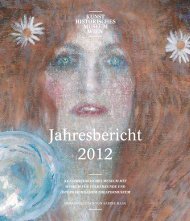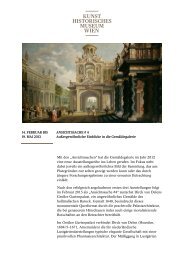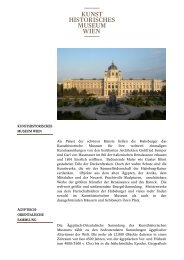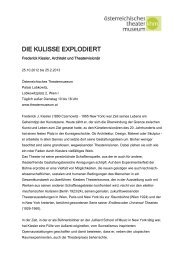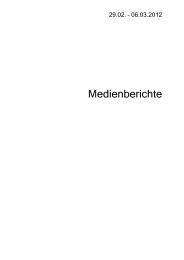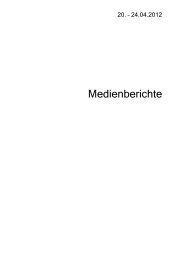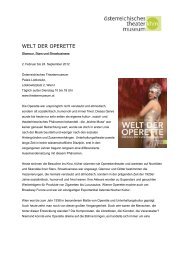Jahresbericht 2011 - Presse - Kunsthistorisches Museum Wien
Jahresbericht 2011 - Presse - Kunsthistorisches Museum Wien
Jahresbericht 2011 - Presse - Kunsthistorisches Museum Wien
Erfolgreiche ePaper selbst erstellen
Machen Sie aus Ihren PDF Publikationen ein blätterbares Flipbook mit unserer einzigartigen Google optimierten e-Paper Software.
khm, museum oF ethnology and austrIan theatre museum, <strong>2011</strong><br />
over the past year, despite the omnipresent international<br />
economic crisis and constrained budgets, more than 1.1<br />
million people visited the collections and attended the<br />
special exhibitions in our museums; the varied programme<br />
that we presented to our public was positively received.<br />
Besides the programme of exhibitions and related events,<br />
a major highlight of the past year was undoubtedly the<br />
opening of our new central depot on the outskirts of<br />
Vienna by the Federal Minister for education, Arts and<br />
culture, claudia Schmied. The construction and fittingout<br />
phase was short and the removal of items from the<br />
former depots occurred smoothly. For the coming decades<br />
the <strong>Kunsthistorisches</strong> <strong>Museum</strong> and its two affiliated<br />
museums have now created a perfectly equipped<br />
museum depot with satisfactory climatic and security<br />
technology.<br />
<strong>2011</strong> was again marked by very intensive construction<br />
work for the collection of Sculpture and Decorative Arts,<br />
which is to be re-opened after being closed for ten years.<br />
Here we are pleased to report great success in the sphere<br />
of fund-raising and the valuable financial support of our<br />
Association of Friends of the <strong>Museum</strong> in Vienna as well<br />
as the international Friends of the <strong>Kunsthistorisches</strong><br />
<strong>Museum</strong>. All management forces of the museum were<br />
also involved in <strong>2011</strong> in evolving a major re-branding<br />
process, and important findings were made in several<br />
workshops as regards a new marketing strategy and the<br />
new positioning of the museums.<br />
By presenting a “Modern and contemporary Programme”<br />
the <strong>Kunsthistorisches</strong> <strong>Museum</strong> aims in future to organise<br />
discussions going beyond the museum’s own collections<br />
in exciting analyses with contemporary artists. one first<br />
major project in this context in <strong>2011</strong> was the presentation<br />
of work by the Belgian artist Jan Fabre in the<br />
Picture Gallery.<br />
The opening of a new creative atelier, varied educational<br />
projects and a diverse programme of events meant that<br />
in <strong>2011</strong> the <strong>Kunsthistorisches</strong> <strong>Museum</strong> was again able to<br />
meet its major core aim of educating and opening up<br />
new circles of visitors. All members of the public under<br />
19 years of age can enter the museum free of charge,<br />
a measure which, in this target group, led to further<br />
increases in the number of visitors. This showed that<br />
here a very important cultural and political step had<br />
been taken.<br />
kunsthIstorIsches museum<br />
notable activities<br />
egyptIan and near eastern collectIon<br />
general reVIsIon oF the InVentory<br />
The egyptian and near eastern collection owns a total of<br />
four inventories: the so-called main inventory (egyptian<br />
inventory), the Semitic inventory, the special inventory<br />
Sichem as well as the archaeological inventory (A-inventory).<br />
As part of a general revision of the inventories,<br />
work commenced on inspecting all inventories in the<br />
egyptian and near eastern collection, but of prime<br />
importance is the inspection of the main inventory and<br />
the archaeological inventory. The successful cooperation<br />
with the scientific association “egypt & Austria” continued<br />
in <strong>2011</strong>. in addition to a six-part series of lectures a study<br />
day on the subject of Ancient Egypt in Travel Literature<br />
was organised.<br />
collectIon oF greek and roman antIQuItIes<br />
concerning the research project Classical Portraits in<br />
Vienna, the main focus was on restoration, the written<br />
and visual documentation of the objects, and on fostering<br />
contacts with the cooperation partner, the Museo del<br />
Prado in Madrid. A further important aspect was the<br />
orientation as part of the international research activity<br />
on the central subject of the project, that is the history of<br />
the classical portrait after it had been found and the<br />
changes made to it until today.<br />
Among the sculptures which had been found in the first<br />
years of the Austrian excavations in ephesus (since 1895),<br />
there were several fragments of a marble frieze with<br />
erotic portrayals. The reliefs come from the scaenae frons,<br />
the rear stage wall of the theatre in ephesus. Work will be<br />
carried out on the frieze and documented in detail, taking<br />
into consideration the fragments that arrived in the<br />
British <strong>Museum</strong> during the 19th century.<br />
collectIon oF sculpture and decoratIVe<br />
arts (kunstkammer), secular and<br />
ecclesIastIcal treasurIes<br />
in <strong>2011</strong> work continued intensively on re-furbishing the<br />
collection of Sculpture and Decorative Arts. in cooperation<br />
with the H. G. Merz office of Architects (Stuttgart) plans<br />
were made for the location of all the objects foreseen for<br />
the new arrangement; the form of their presentation in<br />
the display cases and their didactic relation to each other<br />
were determined. Major aspects of the design of the<br />
exhibition, such as materials, use of colours, seating<br />
facilities, graphic design were elaborated, and samples<br />
made. in <strong>2011</strong> the planning of the display cases was completed.<br />
in addition an extensive concept was evolved for<br />
lighting the rooms and display cases.<br />
Studies continued intensively on the educational concept<br />
elaborated together with the office bogner.cc.<br />
As regards the restoration of objects, extensive conservational<br />
and restorative measures were taken in accordance<br />
with the existing plan.<br />
pIcture gallery<br />
in <strong>2011</strong> the opportunity was seized as part of a threeyear<br />
plan for re-designing the appearance of the gallery.<br />
one of the first aims was to remove the examples of old<br />
German painting from the constricted small corner room<br />
no. 17, originally intended as a provisional solution but<br />
which remained for almost twenty years. Dürer, cranach,<br />
Holbein and other old German masters are now to be<br />
found in Hall XV and the adjoining small room, where<br />
until now only Dutch paintings were on display. The Dutch<br />
schools of painting no longer occupy a large hall – indeed<br />
this does not correspond to their true character – but are on<br />
display in the small rooms between the two larger corner<br />
rooms which are devoted to rembrandt and Vermeer.<br />
in Hall Xii on the other hand a collection of Dutch, Flemish<br />
and German masters from the 16th and 17th centuries are<br />
presented close together and extending right up to the<br />
ceiling. By grouping the paintings together according to<br />
themes and with corresponding formal and decorative<br />
associations, the impression of “Baroque” abundance is<br />
further intensified.<br />
coIn cabInet<br />
Together with the numismatic commission of the<br />
Austrian Academy of Sciences (ÖAW) the coin cabinet<br />
has taken on the digitalisation and scientific classification<br />
summary<br />
of the 1,686 coins which were restored to the Kabul<br />
<strong>Museum</strong> after its destruction in 2003. For this purpose a<br />
special data bank was set up which essentially resembles<br />
that of the Viennese coin cabinet. A final introduction as<br />
to how the data bank functions was offered in the context<br />
of the academic exchange in Vienna, in which six<br />
curators from the Kabul <strong>Museum</strong> took part. in addition,<br />
preliminary preparations were made for an exhibition<br />
showing the monetary history of Afghanistan from the<br />
6 th century B.c. to the present.<br />
collectIon oF ancIent musIcal Instruments<br />
in the collection of ancient musical instruments<br />
christoph Bock, “piano tuner of both imperial and royal<br />
court theatres”, is documented merely by means of the<br />
spinet which is the youngest extant quilled instrument<br />
built in Vienna, and which was probably used for coaching<br />
purposes. in <strong>2011</strong> the spinet was carefully restored.<br />
After the sounding board had been removed, it was<br />
planed, cracks were closed up or cleaned, and loose ribs<br />
were re-glued with a new pre-tension. The dogleg jacks<br />
were fitted extremely precisely; as regards the new<br />
intonation most of the old quills were re-usable. With a<br />
pitch of a1 = 435 Hz and good tuning retention it became<br />
possible to play this continuo instrument again, which<br />
had been unplayable for decades because of climatic<br />
damage.<br />
collectIon oF arms and armour<br />
in the context of the research project on the etched<br />
decoration of German armour from the renaissance,<br />
special attention is given to the œuvre of the graphic<br />
artist from Augsburg Daniel Hopfer (1471–1536) as an<br />
etcher of armour. This field requires particularly detailed<br />
analysis as the great influence of Hopfer’s graphic art on<br />
south-German art makes it difficult to establish whether<br />
the artist carried out the work himself. in the context of<br />
the project a great number of ornamented armours were<br />
studied which are associated with Daniel Hopfer. The<br />
findings from this analysis led to many works being<br />
attributed to him or established as being clearly not by<br />
him, and they were also helpful for dating Hopfer’s<br />
graphic art.<br />
museum oF carrIages and department oF<br />
court unIForms<br />
on 19 June <strong>2011</strong> over 8000 people flocked during the<br />
open Day to the <strong>Museum</strong> of carriages. Besides summary<br />
guided tours and special tours, a full and exciting<br />
programme provided visitors with insights into the<br />
fascinating world of research in the museum and the<br />
opportunity to visit the restoration studios. carriage<br />
rides in the palace gardens and displays by lady horseriders<br />
sitting side-saddle allowed visitors to gain vivid<br />
impressions of the world of the horse and carriage. in<br />
front of the carriage <strong>Museum</strong> a festive marquee was set<br />
up where Maya Hakvoort, star of the musical Elisabeth,<br />
presented highlights; historian Brigitte Hamann spoke<br />
about the life circumstances of the empress, and carolin<br />
Maikler presented her book on elisabeth as a literary<br />
myth; the replica of “Sisi’s” (as elisabeth was known)<br />
wedding stole was also on display. As the crowning finale<br />
of the day Meinhard rüdenauer presented the world<br />
premiere of his “imperial carriage Music”. in addition to<br />
the broad variety of activities for adults there was also an<br />
extensive programme for children: pony rides and workshops<br />
on how to make crowns and carriages.<br />
187




